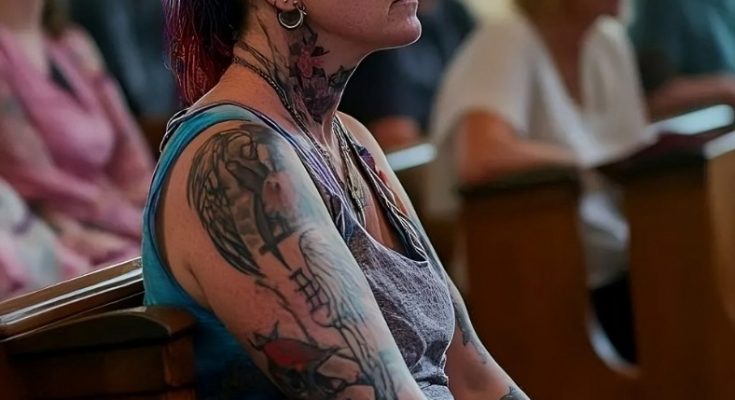Last Sunday, I encountered something at church that challenged my assumptions. As I walked in, I saw a woman, perhaps in her 40s, covered in tattoos and multiple piercings. Growing up, I was taught that church was a place of reverence, where one should dress modestly to show respect. Seeing her in a setting I’ve always viewed as sacred made me uncomfortable, and I couldn’t help but wonder—should there be a dress code in a place of worship?
As I watched the woman, I felt compelled to reflect on my assumptions about what was considered proper in church. After the service, I approached her and mentioned that maybe her appearance was a bit too striking for church. She looked at me with a hint of frustration and replied, “How I look has nothing to do with you.” Her words stung, leaving me feeling unsettled, but they also sparked a moment of self-reflection.
Was my discomfort truly about her appearance, or was it rooted in my own outdated perceptions? Was I holding on to an antiquated idea of what it means to respect a sacred space?
Should Churches Set Standards for Dress?
Many of us have been raised with an image of church attire—modest dresses, neat hairstyles, and, for men, perhaps even a suit and tie. These unwritten guidelines create a sense of uniformity, visually representing reverence. However, as society evolves, so does individual expression. Tattoos and piercings are now mainstream, and what was once seen as rebellious is often simply a reflection of personal style.
Yet, the question persists: should there be an expectation of decorum in church? Some would argue that dressing modestly honors the sacredness of the space, while others feel that one’s appearance should not determine their capacity for worship. After all, isn’t the essence of church about acceptance, compassion, and unity, regardless of outward appearances?
Embracing Diversity in Worship Spaces
Churches are intended to be places of connection and love. When we focus too heavily on appearance, we risk missing the true purpose of these spaces: to bring people closer to God. Judging someone based on visible tattoos or piercings may prevent us from connecting with them on a spiritual level.
It’s essential to remember that everyone comes to church with different backgrounds, and each person’s story is uniquely expressed. Tattoos and piercings can symbolize life experiences, struggles, and triumphs. When we zero in on outward appearances, we might miss the opportunity to share in their journey, to listen, and to understand.
Balancing Tradition and Self-Expression
Maintaining a certain level of decorum can certainly be valuable. For some, dressing modestly or covering tattoos is a way of honoring tradition, showing respect for the place they’re in, and acknowledging the feelings of those who may be less comfortable with unconventional attire.

However, we must also recognize that everyone’s spiritual journey is personal. While one person may feel a strong connection to their faith in traditional church attire, another might feel closer to God when they are free to express themselves authentically. Allowing people to embrace their individuality while being mindful of the sacred space could foster an environment of mutual respect.
Perhaps a middle ground is possible—one where church communities encourage people to dress with consideration for the setting, but also allow room for personal expression. Instead of enforcing strict dress codes, we can gently encourage thoughtfulness about how we present ourselves in a shared space of worship.
The Example of Acceptance and Unity
Religious communities thrive when they are inclusive and welcoming. Jesus himself reached out to those who were marginalized, to those whom society judged. If we wish to embody these values, it’s vital to look beyond appearances and focus on the heart. What truly matters is the intention behind someone’s presence in a place of worship.

When we see someone who doesn’t fit the traditional image of a churchgoer, it offers us a chance to reflect. Perhaps it’s time to grow beyond our assumptions and embrace diversity within our faith communities. By focusing on open-heartedness and inclusivity, we can cultivate a richer, more vibrant community that reflects the diversity of God’s creation.
The Heart of Worship Lies Beyond Appearance
In the end, worship is about far more than how we look. The essence of faith lies in unity, acceptance, and love for all people. So, the next time I see someone who looks different from what I’m used to in church, I’ll remind myself that they are there for the same reason I am—to seek connection with something greater than ourselves.
Ultimately, it’s not the outward appearance that matters, but the sincerity of the heart. If we focus on acceptance rather than judgment, we create a space where everyone feels welcome. And perhaps, in doing so, we come closer to realizing the true purpose of worship: to bring people together in faith, compassion, and unity.
